A fragrant garden – an experience for all the senses
Outdoor plants and garden
A beautiful garden is a delight to the eye. Add delightful scents, and it gains yet another dimension. Few things can trigger our memories quite like fragrances, and they also help us feel more at ease. Here, we take a closer look at how we can work with scents in the garden.


Topics:
Outdoor plants and garden











